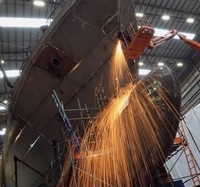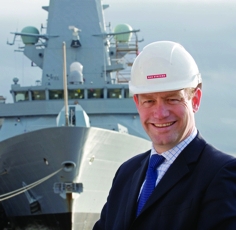There’s a cold northerly wind blowing through Portsmouth Dockyard, and it’s taking Kevin McLeod back to his earliest days in the shipbuilding business. ‘I landed up in Barrow in the winter as a 17 year old, wearing every single piece of clothing my mum had packed for me, building launchways for the second of the Trafalgar-class submarines. The only way we could get warm was to climb up the scaffolding into the anchor recess and get a 30-second blast of heat on your top half, because it was being preheated for welding.’
McLeod, approaching his first anniversary as engineering director for BAE Systems Surface Ships - he took on the role at BVT Surface Fleet, before it was acquired by BAE - has certainly seen many sides of the defence industry. Unusually for someone in such a senior role, he spent his entire 26-year career up to that point as a civil servant, joining the Ministry of Defence (MoD) as a technician apprentice after his O-levels, and acquiring all his further qualifications on the job.
He said: ‘In my first four years, I worked at every major shipbuilding and ship-repair location in the UK, except Devonport. Until now, the only time I’ve spent in the private sector was 14 months during my first degree in ship science - marine architecture, really - when I was in Glasgow designing water taxis for the Thames.’
McLeod’s graduate career started in submarine systems, but the MoD also put him through one of only three specialist warship architecture Masters degree courses in the world; assigned him to a tri-national frigate design project; set him to building nuclear submarine docks at Devonport and initiating the radiological decontamination of Rosyth dockyard. The latter involved one of his more unusual experiences: figuring out how to remove an 18in-thick layer of dead fish from the bed of the Rosyth basin, after a group of seals had chased a huge shoal of sprats in through the dockyard gates. ‘You could smell it 20 miles away,’ he reminisced. ‘And the only way we could get rid of them was to seed the basin with micro-organisms that ate the fish.’
After periods in non-engineering roles on MoD efficiency projects and a role as head of a 100-strong internal consulting team, which would send engineers to find ways to improve the availability of defence equipment in all areas of the armed forces, McLeod was offered the engineering director position at BVT. ‘It was a no-brainer, really,’ he said. ‘I would have a central role in helping to shape the strategy and direction of warship building in the UK over the next 20-30 years. That’s a once-in-a-lifetime opportunity.’

So, after a decade working on land-, sea- and air-defence issues, McLeod finds himself back with his first love - marine architecture - in what he sees as the most exciting time for decades. He said: ‘The shipbuilding programme we are operating at the moment is unprecedented in a generation or more. We’ve just started building the two largest naval warships the Royal Navy has ever seen: the two aircraft carriers Queen Elizabeth and Prince of Wales; 65,000 tonnes each and 280m long. We’ve just launched the fifth Type 45 destroyer, Defender. And we’re about to embark on designing the next generation of frigate to replace the Type 23, with the Future Surface Combatant project.’
“We had 12,000 people turn out for the launch of the Type 45 destroyer, Defender; anything we do here in Portsmouth is national news”
In his first year in the job, McLeod feels he is in his element. ‘The scope of what I find myself interested in now is fantastic, and it’s wonderful to be back in an engineering sphere, using marine and hydrodynamic terminology I haven’t used for years. I’m a hands-on engineer to quite a big degree.’
McLeod has made it his business to get involved in some highly technical aspects of the shipbuilding process, and his enthusiasm for engineering is clear. ‘As I’m a marine architect I’ve made it my personal responsibility to sign off the launch calculations,’ he said, gesturing to show the movements of a warship going down a slipway with his hands. ‘When you’re launching a ship, you’re moving a big lump of steel - 2,000 tonnes for the Trinidad and Tobago offshore patrol vessels (OPVs) we are building at the moment, 6,500 tonnes for a Type 45 - and you have to understand the hydrodynamics. Will it float, first of all; then will it float at the right incline, what the trim will be at bow and stern, and at what point it will start to float. At that point, you have one end floating and one still attached to the land, and that creates a bending moment, which is a structural calculation. We have to demonstrate the factors of safety with the structural integrity of the ship.’
In the current economic climate and with a looming strategic defence review, McLeod accepts that warship builders might face a painful time. ‘But I don’t think either of the carriers will be cancelled,’ he said. ‘One reason is simple - mathematics. We and the MoD have invested so much time, effort and money in the project; we’re now building Queen Elizabeth and we’ve done a batch order for systems and equipment for both ships.’
But McLeod believes naval projects have a more profound role in the UK, to do with national identity. ‘We have a real interest in shipbuilding here. We had 12,000 people turn out in Govan for the launch of Defender; anything we do herein Portsmouth is national news. The carrier project tells us something about what this country needs to be. We have to think, as a nation, whether we want to maintain a high-tech industrial capability. It would be a brave government that says: “Well, actually, we don’t want those carriers”.’

kevin mcleod biography
Engineering director
BAE Systems Surface Ships
Education
1989 Graduated from MoD-sponsored degree in Ship Science
1991 MSc in Naval Architecture, UCL
2002 MBA from University of Bath
Career
1982 Joined MoD as technician apprentice
1991 Submarine naval architecture section in Bath
1994 Responsible for ship systems on tri-national HORIZON frigate project
1997 Project contract manager for nuclear submarine docking facilities at Devonport dockyard
1998 Role expanded to include Rosyth dockyard; initiated radiological decontamination programme
2002 Programme director on Change Management project at MoD
2004 Programme director for communications and change for the Defence Logistics Transformation Programme
2006 Director of equipment services and continuous improvement team
2009 Left MoD to join BVT Surface Systems; BVT acquired by BAE Systems
Q&A: Computing advances can optimise ship support
What are the technological challenges ahead for surface ships, in your opinion?
There’s little chance of finding a technology that will give us a step change in ship performance. The bulbous bow and transom flaps help us go a bit faster, but the hull form is the hull form. Inboard, we’ve got the computing power and I think we’re going to make the biggest improvements there. One of the ways I want to harness that is to bring the afloat and onshore engineers closer together, in terms of information sharing.
How will that improve performance?
It’ll help us understand what’s happening at sea, so we can use the data associated with a particular ship to improve reliability and availability and better predict how to support our ships. We could use that information to look at the systems afloat, so our onshore engineers can say ‘the ship is coming into dock in three weeks’ time and these systems are starting to underperform’. We’d be able to predict that underperformance and replace the system, or part of it.
Would that be different from the current practices?
Fifteen years ago, when a submarine came into dock, you’d take out every system apart from the reactor and replace them, irrespective of condition. It’s far more intelligent not to replace systems that are performing adequately — we can just test them to make sure they’re OK. We’re moving away from that now. The cost of building a ship and putting it in the water is only 20-30 per cent of its through-life cost, and we can optimise that; but the prize is to increase the cost-effectiveness of the support phase, while it’s in service.
Will that affect how you design and build the ships?
Royal Navy ships are designed to go to war. We need to design them to be as reliable as possible, and that means speeding up the response times from the engineers ashore to the engineers onboard. Part of that will be about greater use of condition-monitoring equipment, for example, but some of it is just about how you connect these two groups of engineers. The crew on a Type 45 destroyer will be in a particular set of conditions, and the team onshore might have all its data, but it’ll also have data from the other five Type 45s. The picture we can build from that data can give us a much better support capability.
And in terms of the ships themselves?
We have to think about what we can design into the ships to make them easier to support. Some of these features might make the ship more expensive to acquire and to put in the water, but they’ll make it simpler and more cost-effective to maintain when they are in service, and that will keep them available throughout their operational life.




JLR teams with Allye Energy on portable battery storage
This illustrates the lengths required to operate electric vehicles in some circumstances. It is just as well few electric Range Rovers will go off...